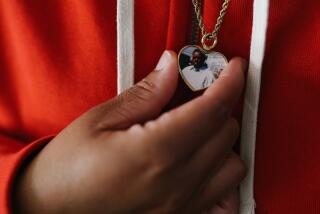Coronavirus infection rates in some parts of L.A. County jails are 40% or higher
- Share via
As extensive testing for the novel coronavirus gets underway in the vast Los Angeles County jail system, high infection rates are emerging, with nearly 60% of one group of inmates testing positive.
Among 600 inmates at North County Correctional Facility in Castaic who were without symptoms and living in the general population, 40% tested positive, indicating that herd immunity “is starting to take effect,” Sheriff Alex Villanueva said at a news briefing Wednesday.
At Men’s Central Jail, nearly 60% in a dorm of 67 asymptomatic inmates tested positive for the coronavirus, according to Inspector General Max Huntsman, an independent watchdog for the L.A. County Sheriff’s Department.
But Villanueva said the number of inmates with symptoms of COVID-19, the disease caused by the coronavirus, has gone down, putting the jails “in a better place than we were were a week ago, when we were in the opposite direction.”
Patrisse Cullors, chairwoman and founder of Reform L.A. Jails, which has pushed for universal testing in the jails and more inmates to be released early, called the sheriff’s herd immunity theory “ignorant and incredibly risky.”
“The numbers he announced are appalling,” she said. “It shows there’s an outbreak in the jails.”
Huntsman said last week that the jails are violating guidelines from the federal Centers for Disease Control and Prevention for physical distancing and testing in correctional facilities.
“There’s now a full-blown epidemic within a pandemic in our jail,” he said. “So we have an environment where people are sleeping close together. There’s no way that sleeping head to toe or cutting down the numbers a little bit is going to make a difference.”
The percentage of a population needed to achieve herd immunity varies depending on how easily the virus is spreading, according to a paper about the novel coronavirus in the Emerging Infectious Diseases journal posted online in advance of its July publication date.
If each infected person gives the virus to roughly two people, 55% need to have already had the virus or have been vaccinated to prevent further spread. If each person gives the virus to an average of nearly six people, the threshold for herd immunity rises to 82%, according to the paper by Steven Sanche, Yen Ting Lin and four other scientists at the Los Alamos National Laboratory.
Infectious diseases can spread rapidly among tight living quarters in jails and prisons. At the Lompoc and Terminal Island federal prisons in California, a combined total of 1,800 inmates have been infected with the coronavirus, and 10 have died.
In the L.A. County jails, more than 1,000 inmates in a population of nearly 13,000 have tested positive, along with 250 Sheriff’s Department employees, including some who do not work in the jails. One jail nurse has died of the virus.
More than 5,100 inmates, or nearly 40% of the jail population, are under quarantine.
But without testing of all inmates, including those without symptoms, it is unclear how widespread the virus is in the county jails.
Testing of asymptomatic inmates was completed in the women’s jail last week, with the goal of testing all inmates in the county system by mid-June, Assistant Sheriff Bruce Chase said last week. All inmates entering the jails are now tested for the coronavirus.
To create more physical distance behind bars, county officials have reduced the number of inmates by more than 20%, from a typical population of 17,000. But the jails still house some nonviolent offenders and those whose age or preexisting medical conditions make them especially vulnerable to the virus.
With inmates and employees coming and going, outbreaks in the jails can easily spread to the general public.
This month, Villanueva released surveillance video of inmates at the North County Correctional Facility drinking water from the same container in what he described as an attempt to spread the coronavirus to one another and obtain early release.
The day after the incident in late April, nine inmates fell ill and were removed from the dorm, with 21 eventually testing positive for the virus, Sheriff’s Department officials said.
But critics say the video does not prove the inmates’ intent. Cullors said the sheriff was trying to gaslight the public by blaming inmates for the spread of the virus.
“Not a single person inside wants COVID-19,” she said.
At last week’s Sheriff Civilian Oversight Commission meeting, Cheryl Grills, vice chairwoman of the Sybil Brand Commission for Institutional Inspections, reported on visits she made to three county jails and interviews she conducted with inmates.
At the women’s jail, trustee inmates who cook and clean said they moved freely from quarantined areas to nonquarantined areas without any sanitary precautions, which made them afraid of contracting the virus.
Trustees performing deep cleaning of jail facilities were not provided with a change of clothes afterwards, Grills said.
Though most inmates in the women’s jail were wearing masks, almost no men were, Grills said. The North County Correctional Facility had no procedure for deep cleaning, with each inmate responsible for cleaning his own living area.
Chase, the assistant sheriff, said there were structural issues in the jails, such as triple bunks bolted to the floor, that made social distancing difficult.
It is hard to get inmates to wear masks and keep six feet from one another when they are essentially at home, Chase added.
Villanueva had defied a subpoena to testify at the meeting about jail conditions, sending Chase instead.
More to Read
Sign up for Essential California
The most important California stories and recommendations in your inbox every morning.
You may occasionally receive promotional content from the Los Angeles Times.











